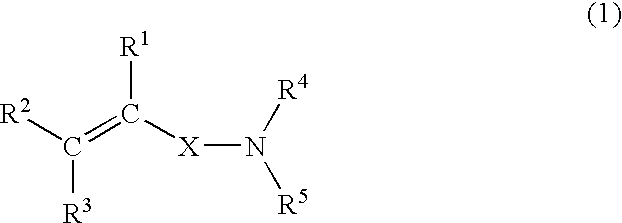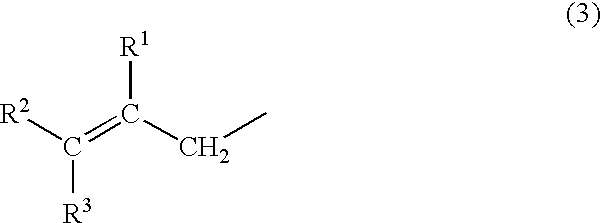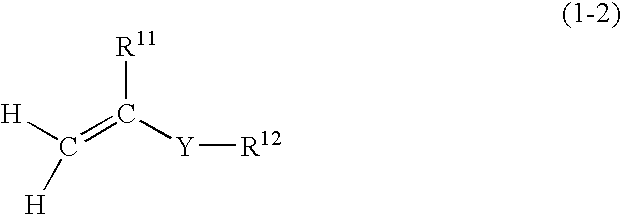Fiber treating agent
a fiber and treating agent technology, applied in detergent compositions, detergent compounding agents, chemistry apparatus and processes, etc., can solve the problems of monotonous fragrance of dried fiber products, inability to really satisfy users who need fragrance, and use of perfumes with high clogging, so as to facilitate adsorption of perfum
- Summary
- Abstract
- Description
- Claims
- Application Information
AI Technical Summary
Benefits of technology
Problems solved by technology
Method used
Image
Examples
preparation example 1-1
[0080]36.0 g of N,N-dimethylaminoethyl methacrylate (molecular weight: 157.21), 14.0 g of butyl methacrylate (molecular weight: 142.2), and 180.0 g of ethanol were uniformly mixed, charged in 300 mL glass separable flask, and stirred for a given time under nitrogen atmosphere. To this was added 1.41 g of 2,2′-azobis(2,4-dimethylvaleronitrile) (V-65; Wako Pure Chemical Industries, Ltd.) dissolved in 20.0 g of ethanol, and risen to around 60° C. The mixture was kept at about 60 to 70° C. for 8 hours for polymerization and aging. To this was added 100.0 g of ethanol to dilute, and cooled to room temperature. The reaction mixture was poured into 4000.0 g of ion-exchanged water dropwise for purification by precipitation. The precipitated product was dried to give a polymer 1-a1. The polymer 1-a1 had an Mw of 12800 (water / ethanol=7 / 3 system, calculated based on polyethylene oxide). A composition of the polymer 1-a1 was as expected from the composition of monomers used (DMAEMA / BMA=70 / 30 (m...
examples 1-3
[0104]Liquid detergent compositions were prepared using components described below and perfume components listed in Table 1-3 used in the perfume composition 1-B, and evaluated for perfume-remaining properties by the method described below. Results are shown in Table 1-6.
[0105]To a washing tub of an automatic washing machine (TOSHIBA AW-D802VP) was charged 30 L of tap water and 40 ml of laundry liquid detergent composition listed in Table 1-5 (preparation of treatment bath containing a perfume component). A commercially available cotton towel (Takei towel, TW220: cotton 100%) was charged in the tub, and subjected to washing of a standard course (liquid after washing). In washing, the commercially available cotton towel was a pre-treated towel obtained by washing 20 cotton towels (Takei towel, TW220: cotton 100%) 5 times with a commercially available weak alkaline detergent (Attack, Kao Corporation) in a HITACHI automatic washing machine NW-6CY and drying in a room to remove excess a...
preparation example 2-1
[0111]42.37 g of N,N-dimethylaminoethyl methacrylate (molecular weight: 157.21), 7.62 g of lauryl methacrylate (molecular weight: 254.21), and 180.0 g of ethanol were uniformly mixed. In a 300 mL glass separable flask, the mixture was stirred for a given time under nitrogen atmosphere. To this was added a solution of 1.41 g of 2,2′-azobis(2,4-dimethylvaleronitrile) (V-65; Wako Pure Chemical Industries, Ltd.) in 20.0 g of ethanol, and raised to around 60° C. The mixture was held around 60 to 70° C. for total 8 hours to polymerize / mature. To this was added 100.0 g of ethanol, and cooled to room temperature. The reaction mixture was poured into 4000.0 g of ion-exchanged water dropwise for purification by precipitation. The precipitated product was dried to give a polymer 2-a1. The polymer 2-a1 had an Mw of 11000 (water / ethanol=7 / 3 system, calculated based on polyethylene oxide). A composition of the polymer 2-a1 was as expected from the composition of monomers used (DMAEMA / LMA=90 / 10 (m...
PUM
| Property | Measurement | Unit |
|---|---|---|
| molar ratio | aaaaa | aaaaa |
| logP | aaaaa | aaaaa |
| pH | aaaaa | aaaaa |
Abstract
Description
Claims
Application Information
 Login to View More
Login to View More - R&D
- Intellectual Property
- Life Sciences
- Materials
- Tech Scout
- Unparalleled Data Quality
- Higher Quality Content
- 60% Fewer Hallucinations
Browse by: Latest US Patents, China's latest patents, Technical Efficacy Thesaurus, Application Domain, Technology Topic, Popular Technical Reports.
© 2025 PatSnap. All rights reserved.Legal|Privacy policy|Modern Slavery Act Transparency Statement|Sitemap|About US| Contact US: help@patsnap.com



